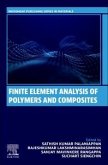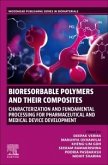3D Printing of Polymer Composites
Fibers, Particles and Matrix
Herausgeber: Ayyappan, Vinod; Siengchin, Suchart; Rangappa, Sanjay Mavinkere; Tengsuthiwat, Jiratti; Raghunathan, Vijay
Versandkostenfrei innerhalb Deutschlands
274,99 €
inkl. MwSt.
Versandkostenfrei*
Erscheint vorauss. 1. Mai 2026
Melden Sie sich
hier
hier
für den Produktalarm an, um über die Verfügbarkeit des Produkts informiert zu werden.

137 °P sammeln
3D Printing of Polymer Composites
Fibers, Particles and Matrix
Herausgeber: Ayyappan, Vinod; Siengchin, Suchart; Rangappa, Sanjay Mavinkere; Tengsuthiwat, Jiratti; Raghunathan, Vijay
- Broschiertes Buch
3D Printing of Polymer Composites: Fibers, Particles and Matrix explores in detail the complexities of the dynamic interplay between these three components and their interactions in the polymer-based 3D printing process. The book includes information on the theoretical foundations as well as practical applications. The book provides insights into optimizing material compositions, overcoming challenges related to fiber and particle integration, and to enhancing the overall print quality of the material and final component. The book will be a valuable reference resource that educates the…mehr
Andere Kunden interessierten sich auch für
![Finite Element Analysis of Polymers and Composites Finite Element Analysis of Polymers and Composites]() Finite Element Analysis of Polymers and Composites195,99 €
Finite Element Analysis of Polymers and Composites195,99 €![Polymer Blend Nanocomposites for Energy Storage Applications Polymer Blend Nanocomposites for Energy Storage Applications]() Polymer Blend Nanocomposites for Energy Storage Applications233,99 €
Polymer Blend Nanocomposites for Energy Storage Applications233,99 €![Bioresorbable Polymers and Their Composites Bioresorbable Polymers and Their Composites]() Bioresorbable Polymers and Their Composites255,99 €
Bioresorbable Polymers and Their Composites255,99 €![Polymer Micro and Nanocomposites for High Voltage Insulation Polymer Micro and Nanocomposites for High Voltage Insulation]() Polymer Micro and Nanocomposites for High Voltage Insulation188,99 €
Polymer Micro and Nanocomposites for High Voltage Insulation188,99 €![Nanostructured Materials for Food Packaging Applications Nanostructured Materials for Food Packaging Applications]() Nanostructured Materials for Food Packaging Applications205,99 €
Nanostructured Materials for Food Packaging Applications205,99 €![Polyurethane Nanocomposites Polyurethane Nanocomposites]() Polyurethane Nanocomposites338,99 €
Polyurethane Nanocomposites338,99 €![Sensory Polymers Sensory Polymers]() Sensory Polymers249,99 €
Sensory Polymers249,99 €-
-
-
3D Printing of Polymer Composites: Fibers, Particles and Matrix explores in detail the complexities of the dynamic interplay between these three components and their interactions in the polymer-based 3D printing process. The book includes information on the theoretical foundations as well as practical applications. The book provides insights into optimizing material compositions, overcoming challenges related to fiber and particle integration, and to enhancing the overall print quality of the material and final component. The book will be a valuable reference resource that educates the researcher on the intricacies of this technology, enabling them to make informed decisions, to troubleshoot key challenges, and to push the boundaries on what is possible in the future for polymer-based additive manufacturing.
Produktdetails
- Produktdetails
- Verlag: Elsevier Science
- Seitenzahl: 680
- Erscheinungstermin: 1. Mai 2026
- Englisch
- ISBN-13: 9780443403408
- ISBN-10: 0443403406
- Artikelnr.: 75536196
- Herstellerkennzeichnung
- Libri GmbH
- Europaallee 1
- 36244 Bad Hersfeld
- gpsr@libri.de
- Verlag: Elsevier Science
- Seitenzahl: 680
- Erscheinungstermin: 1. Mai 2026
- Englisch
- ISBN-13: 9780443403408
- ISBN-10: 0443403406
- Artikelnr.: 75536196
- Herstellerkennzeichnung
- Libri GmbH
- Europaallee 1
- 36244 Bad Hersfeld
- gpsr@libri.de
Section 1: Introduction and Advances in 3D Printing of Polymer Composites
1. 3D-Printing: The state of the art- Introduction
2. Advances in additive manufacturing of polymer composites: Material and
binder jetting, Sheet lamination, and SLS innovations
3. Advancements in the reinforcement strategies of SLA and DLP printing of
polymer composites
4. The role of artificial intelligence, machine learning, and finite
element modelling in additive manufacturing of polymer composites
5. Optimization of process parameters for the 3D printing of composites:
Materials a key deciding factor
Section 2: Fiber Reinforcement Strategies in 3D Printing
6. Natural and Synthetic Fibers: Pathway to eco-friendly and
high-performance 3D printing of lightweight composites
7. The role of synthetic fibers in 3D printing: Continuous and
Discontinuous Fibers Effect
8. Effect of surface treatment on fiber wettability and Static-Dynamic,
Thermal, and Water absorption characteristics of natural/synthetic
fibers-based 3D printed composites
9. Effect of fiber size and reinforcement percentage over the 3D
printability of polymer composites
10. Thermoplastics-Matrix for 3D printing: Types, Filament/Component
Manufacturing, Characterization
11. Role of thermosets in 3D printing: Latest advancements & Challenges
Section 3: Fillers, Nanomaterials, and Performance in 3D Printing
12. Influence of organic/inorganic fillers on the performance behavior of
3D printing of composites: pros and cons
13. Tribological behavior of filler reinforced 3D printed composites:
influence of inorganic/organic and solid lubricants
14. Effect of size, shape, and loading contents of the fillers in polymer
composites for additive manufacturing.
15. Nanomaterials on 3D printing: Types, Development, and Characterization
16. Numerical Simulation of Particle reinforced 3D printed composites.
Section 4: Applications and Environmental Impact of 3D Printing
17. Hybrid Metal-Plastic Structures: Next Generation of 3D-Printing-
Manufacturing Techniques and Applications
18. Recycled materials in polymer additive manufacturing: A cost-effective
approach
19. Role of composites 3D printing in automobile and construction
components
20.Influence of particles and fibers with matrix on the 3D printing of
composites for medical applications
21. Effect of particles and fibers on the 3D printing of components for
Energy storage and electronics applications
22. Impact of fibers, particles, and matrix in the waste reduction of 3D
printed composites: Carbon footprint approaches
23. Life Cycle Assessment (LCA) of 3D Printed Composites: A Perspective
Review
1. 3D-Printing: The state of the art- Introduction
2. Advances in additive manufacturing of polymer composites: Material and
binder jetting, Sheet lamination, and SLS innovations
3. Advancements in the reinforcement strategies of SLA and DLP printing of
polymer composites
4. The role of artificial intelligence, machine learning, and finite
element modelling in additive manufacturing of polymer composites
5. Optimization of process parameters for the 3D printing of composites:
Materials a key deciding factor
Section 2: Fiber Reinforcement Strategies in 3D Printing
6. Natural and Synthetic Fibers: Pathway to eco-friendly and
high-performance 3D printing of lightweight composites
7. The role of synthetic fibers in 3D printing: Continuous and
Discontinuous Fibers Effect
8. Effect of surface treatment on fiber wettability and Static-Dynamic,
Thermal, and Water absorption characteristics of natural/synthetic
fibers-based 3D printed composites
9. Effect of fiber size and reinforcement percentage over the 3D
printability of polymer composites
10. Thermoplastics-Matrix for 3D printing: Types, Filament/Component
Manufacturing, Characterization
11. Role of thermosets in 3D printing: Latest advancements & Challenges
Section 3: Fillers, Nanomaterials, and Performance in 3D Printing
12. Influence of organic/inorganic fillers on the performance behavior of
3D printing of composites: pros and cons
13. Tribological behavior of filler reinforced 3D printed composites:
influence of inorganic/organic and solid lubricants
14. Effect of size, shape, and loading contents of the fillers in polymer
composites for additive manufacturing.
15. Nanomaterials on 3D printing: Types, Development, and Characterization
16. Numerical Simulation of Particle reinforced 3D printed composites.
Section 4: Applications and Environmental Impact of 3D Printing
17. Hybrid Metal-Plastic Structures: Next Generation of 3D-Printing-
Manufacturing Techniques and Applications
18. Recycled materials in polymer additive manufacturing: A cost-effective
approach
19. Role of composites 3D printing in automobile and construction
components
20.Influence of particles and fibers with matrix on the 3D printing of
composites for medical applications
21. Effect of particles and fibers on the 3D printing of components for
Energy storage and electronics applications
22. Impact of fibers, particles, and matrix in the waste reduction of 3D
printed composites: Carbon footprint approaches
23. Life Cycle Assessment (LCA) of 3D Printed Composites: A Perspective
Review
Section 1: Introduction and Advances in 3D Printing of Polymer Composites
1. 3D-Printing: The state of the art- Introduction
2. Advances in additive manufacturing of polymer composites: Material and
binder jetting, Sheet lamination, and SLS innovations
3. Advancements in the reinforcement strategies of SLA and DLP printing of
polymer composites
4. The role of artificial intelligence, machine learning, and finite
element modelling in additive manufacturing of polymer composites
5. Optimization of process parameters for the 3D printing of composites:
Materials a key deciding factor
Section 2: Fiber Reinforcement Strategies in 3D Printing
6. Natural and Synthetic Fibers: Pathway to eco-friendly and
high-performance 3D printing of lightweight composites
7. The role of synthetic fibers in 3D printing: Continuous and
Discontinuous Fibers Effect
8. Effect of surface treatment on fiber wettability and Static-Dynamic,
Thermal, and Water absorption characteristics of natural/synthetic
fibers-based 3D printed composites
9. Effect of fiber size and reinforcement percentage over the 3D
printability of polymer composites
10. Thermoplastics-Matrix for 3D printing: Types, Filament/Component
Manufacturing, Characterization
11. Role of thermosets in 3D printing: Latest advancements & Challenges
Section 3: Fillers, Nanomaterials, and Performance in 3D Printing
12. Influence of organic/inorganic fillers on the performance behavior of
3D printing of composites: pros and cons
13. Tribological behavior of filler reinforced 3D printed composites:
influence of inorganic/organic and solid lubricants
14. Effect of size, shape, and loading contents of the fillers in polymer
composites for additive manufacturing.
15. Nanomaterials on 3D printing: Types, Development, and Characterization
16. Numerical Simulation of Particle reinforced 3D printed composites.
Section 4: Applications and Environmental Impact of 3D Printing
17. Hybrid Metal-Plastic Structures: Next Generation of 3D-Printing-
Manufacturing Techniques and Applications
18. Recycled materials in polymer additive manufacturing: A cost-effective
approach
19. Role of composites 3D printing in automobile and construction
components
20.Influence of particles and fibers with matrix on the 3D printing of
composites for medical applications
21. Effect of particles and fibers on the 3D printing of components for
Energy storage and electronics applications
22. Impact of fibers, particles, and matrix in the waste reduction of 3D
printed composites: Carbon footprint approaches
23. Life Cycle Assessment (LCA) of 3D Printed Composites: A Perspective
Review
1. 3D-Printing: The state of the art- Introduction
2. Advances in additive manufacturing of polymer composites: Material and
binder jetting, Sheet lamination, and SLS innovations
3. Advancements in the reinforcement strategies of SLA and DLP printing of
polymer composites
4. The role of artificial intelligence, machine learning, and finite
element modelling in additive manufacturing of polymer composites
5. Optimization of process parameters for the 3D printing of composites:
Materials a key deciding factor
Section 2: Fiber Reinforcement Strategies in 3D Printing
6. Natural and Synthetic Fibers: Pathway to eco-friendly and
high-performance 3D printing of lightweight composites
7. The role of synthetic fibers in 3D printing: Continuous and
Discontinuous Fibers Effect
8. Effect of surface treatment on fiber wettability and Static-Dynamic,
Thermal, and Water absorption characteristics of natural/synthetic
fibers-based 3D printed composites
9. Effect of fiber size and reinforcement percentage over the 3D
printability of polymer composites
10. Thermoplastics-Matrix for 3D printing: Types, Filament/Component
Manufacturing, Characterization
11. Role of thermosets in 3D printing: Latest advancements & Challenges
Section 3: Fillers, Nanomaterials, and Performance in 3D Printing
12. Influence of organic/inorganic fillers on the performance behavior of
3D printing of composites: pros and cons
13. Tribological behavior of filler reinforced 3D printed composites:
influence of inorganic/organic and solid lubricants
14. Effect of size, shape, and loading contents of the fillers in polymer
composites for additive manufacturing.
15. Nanomaterials on 3D printing: Types, Development, and Characterization
16. Numerical Simulation of Particle reinforced 3D printed composites.
Section 4: Applications and Environmental Impact of 3D Printing
17. Hybrid Metal-Plastic Structures: Next Generation of 3D-Printing-
Manufacturing Techniques and Applications
18. Recycled materials in polymer additive manufacturing: A cost-effective
approach
19. Role of composites 3D printing in automobile and construction
components
20.Influence of particles and fibers with matrix on the 3D printing of
composites for medical applications
21. Effect of particles and fibers on the 3D printing of components for
Energy storage and electronics applications
22. Impact of fibers, particles, and matrix in the waste reduction of 3D
printed composites: Carbon footprint approaches
23. Life Cycle Assessment (LCA) of 3D Printed Composites: A Perspective
Review







